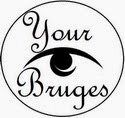In the last
story I told you about the Simon Stevin square. Well, next to the fun story
about the square and its sculpture there is another rather amusing thing to
tell.
I mentioned
the best chocolate store in the city being “The Chocolate Line”.
This building has some (hi)story !
This building has some (hi)story !
In 1700,
the building was an inn called “The White Horse”. No, not the “Prancing Pony”,
that’s in the Lord of the Rings books and movies.
Nothing special about it, if it weren’t for a young man of 24 who stayed there for one night.
Guillaume Van Lee wasn’t a special man who did anything extraordinary in his life, so when he decided to choose the easy way to get rich he had no idea what the consequences would be.
Close by there is the cathedral of Saint Salvator where there were at that moment several chapels inside. When you look inside a church, you can see separate chapels on the side. Those were donated, installed by rich people or guilds from different professions.
Guillaume broke in the cathedral on the night of June 15th 1700 and took a pyx with him. A pyx is a round container (used in the catholic churches), mostly in silver or gold, to hold the consecrated host (bread). This particular one held 400 hosts, so it was a big one!
Nothing special about it, if it weren’t for a young man of 24 who stayed there for one night.
Guillaume Van Lee wasn’t a special man who did anything extraordinary in his life, so when he decided to choose the easy way to get rich he had no idea what the consequences would be.
Close by there is the cathedral of Saint Salvator where there were at that moment several chapels inside. When you look inside a church, you can see separate chapels on the side. Those were donated, installed by rich people or guilds from different professions.
Guillaume broke in the cathedral on the night of June 15th 1700 and took a pyx with him. A pyx is a round container (used in the catholic churches), mostly in silver or gold, to hold the consecrated host (bread). This particular one held 400 hosts, so it was a big one!
Guillaume
was feeling pretty confident, because after the theft he stayed for the night
at the inn “The White Horse”. On his room he looked at his loot. The pyx was
made of silver, that was really useable. The hosts on the other hand were worth
nothing.
So he threw all 400 hosts in the toilet. Well, toilet… In those days that was a cesspool with some planks over it.
Guillaume left the city the very next day. He travelled to Sluis, a neighbouring city (today that’s just across the border in the Netherlands). When he tried to sell the pyx to a smith, the man found it strange that this shabby-looking man brought in such an expensive item. The smith alerted the guards and Guillaume was taken prisoner.
After a little bit of “interrogation techniques from the Middle Ages” he confessed he stole the pyx in Bruges. So he was brought back to the city. On June 26th Guillaume was punished for his crime.
I must confess, in the Middle Ages they were pretty nasty. First the hands were cut off, for the stealing. Then he was strangled to a pole, his body was burned and the ashes scattered outside the city walls (no holy ground).
So he threw all 400 hosts in the toilet. Well, toilet… In those days that was a cesspool with some planks over it.
Guillaume left the city the very next day. He travelled to Sluis, a neighbouring city (today that’s just across the border in the Netherlands). When he tried to sell the pyx to a smith, the man found it strange that this shabby-looking man brought in such an expensive item. The smith alerted the guards and Guillaume was taken prisoner.
After a little bit of “interrogation techniques from the Middle Ages” he confessed he stole the pyx in Bruges. So he was brought back to the city. On June 26th Guillaume was punished for his crime.
I must confess, in the Middle Ages they were pretty nasty. First the hands were cut off, for the stealing. Then he was strangled to a pole, his body was burned and the ashes scattered outside the city walls (no holy ground).
The problem
of the cesspool was to be taken care of now.
Imagine
yourself being in those times, religion was a really biiiiig thing! Throwing
hosts in a toilet, that was sacrilege!
I’m not making this up, but they tried to find all the hosts in the cesspool! Yes, going through all that sh!t. Of course you can imagine that this was impossible. So they just emptied the cesspool and buried the contents on the cemetery of Saint Salvator. Yes, they buried a pile of crap.
I’m not making this up, but they tried to find all the hosts in the cesspool! Yes, going through all that sh!t. Of course you can imagine that this was impossible. So they just emptied the cesspool and buried the contents on the cemetery of Saint Salvator. Yes, they buried a pile of crap.
 |
| The chapel that was built |
Because the
hosts weren’t found, the ground of the inn was considered sacred so the inn was
demolished and a small chapel in honour of the Saint Sacrament was build.
During the French period, this chapel was sold in public and destroyed.
But,
remember now, throwing a host in the toilet can have big consequences !







